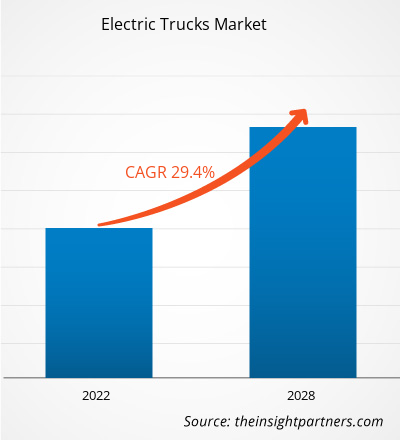预计到2034年,电动卡车市场规模将从2025年的1251万美元增长至1.1943亿美元。预计在2026年至2034年的预测期内,该市场将保持28.5%的强劲复合年增长率(CAGR)。
电动卡车市场分析
电动卡车市场预测显示,在全球日益严格的排放法规、电池技术和储能解决方案的快速发展以及物流、运输和电子商务等关键垂直行业中零排放车辆使用率不断提高的推动下,市场将呈现强劲增长势头。政府激励措施和企业可持续发展目标极大地促进了市场扩张,加速了全球车队电气化进程。原始设备制造商 (OEM) 也积极响应,加大研发投入,以提升车辆续航里程、扩展充电基础设施生态系统,并集成先进的自动驾驶和远程信息处理功能,从而将电动卡车打造成为未来可持续物流链的核心组成部分。
电动卡车市场概览
电动卡车是指从轻型货车到重型铰接式卡车等各种商用车辆,其全部或部分动力来自电力驱动系统,能量储存在车载电池中或由燃料电池提供。与传统的柴油卡车相比,电动卡车具有诸多优势,包括显著减少温室气体排放、降低噪音污染以及大幅降低运营成本。其应用领域日益广泛,涵盖城市物流、最后一公里配送、区域长途运输以及专业建筑行业等。全球市场增长的核心动力来自雄心勃勃的脱碳目标、电池组成本的降低,以及氢燃料电池技术的崛起——该技术有望成为满足重型长途运输迫切需求的实用解决方案。
根据您的需求定制此报告
您可以免费获得任何报告的定制服务,包括本报告的部分内容、国家/地区层面的分析、Excel 数据包,以及面向初创企业和高校的优惠折扣。
电动卡车市场:战略洞察

-
获取本报告的主要市场趋势。这份免费样品将包含数据分析,内容涵盖市场趋势、估算和预测等。
电动卡车市场驱动因素和机遇
市场驱动因素:
- 严格的排放标准和全球脱碳目标:世界各国政府,尤其是在城市地区和主要交通走廊沿线,正日益严格地实施针对商用车辆的零排放强制规定。这种监管压力迫使物流供应商和车队运营商尽快从燃油车转向可持续的电动车。
- 燃料成本上涨与对高性价比物流的需求:传统燃料价格波动高昂,使得电动卡车的总体拥有成本 (TCO) 越来越具有吸引力。电动平台维护需求更低,每英里能耗更低,为大规模车队现代化改造和效率提升提供了强有力的经济动力。
- 电池能量密度和充电基础设施的技术进步:锂离子电池和固态电池技术的持续创新正在快速提高能量密度,从而直接延长车辆续航里程。同时,移动充电系统(MCS)和专用大功率充电基础设施的部署极大地缓解了里程焦虑,使电动卡车能够胜任中长途运输业务。
市场机遇:
- 新兴市场电动汽车扶持政策助力市场扩张:新兴经济体,尤其是亚太和拉丁美洲的新兴经济体,蕴藏着巨大的未开发市场。这些地区的政府补贴、有利的监管框架以及快速增长的电子商务行业,为电动卡车制造商扩大运营规模和市场份额创造了巨大机遇。
- 自动驾驶与先进远程信息处理技术的融合:电动动力系统技术与自动驾驶系统的融合带来了革命性的机遇。目前,汽车制造商正在试点半自动驾驶和全自动驾驶电动卡车,这些卡车有望进一步降低运营成本、提升驾驶员安全,并高效利用货运运力。
- 氢燃料电池卡车加速发展:氢燃料电池汽车(FCV)正在解决重型长途运输应用中电池重量和充电时间的限制。FCV 具有加氢快捷、续航里程长的优势,使其成为零排放城际和跨州货运的理想且极具市场潜力的选择。
电动卡车市场报告细分分析
我们对电动卡车市场份额进行了多维度分析,以更清晰地了解其结构、增长潜力以及技术和应用方面的新兴趋势。以下是大多数行业报告中常用的标准细分方法:
推进方式:
- 电池电动汽车(BEV)
- 插电式混合动力汽车(PHEV)
- 燃料电池汽车(FCV)
按车辆类型:
- 轻型商用车(LCV)
- 中型和重型商用车辆 (HCV)
按范围:
- 不到200英里
- 超过200英里
按自动化程度划分:
- 半自主
- 完全自主
按地理位置:
- 北美
- 欧洲
- 亚太地区
- 南美洲和中美洲
- 中东和非洲
电动卡车市场区域洞察
The Insight Partners 的分析师对预测期内影响电动卡车市场的区域趋势和因素进行了详尽的阐述。本节还探讨了北美、欧洲、亚太、中东和非洲以及南美和中美洲等地区的电动卡车市场细分和地域分布。
电动卡车市场报告范围
| 报告属性 | 细节 |
|---|---|
| 2025年市场规模 | 1251万美元 |
| 到2034年市场规模 | 1.1943亿美元 |
| 全球复合年增长率(2026-2034 年) | 28.5% |
| 史料 | 2021-2024 |
| 预测期 | 2026-2034 |
| 涵盖部分 |
通过推进
|
| 覆盖地区和国家 |
北美
|
| 市场领导者和主要公司简介 |
|
电动卡车市场参与者密度:了解其对商业动态的影响
电动卡车市场正快速增长,这主要得益于终端用户需求的不断增长,而终端用户需求的增长又源于消费者偏好的转变、技术的进步以及消费者对产品优势认知的提高。随着需求的增长,企业不断拓展产品和服务,持续创新以满足消费者需求,并把握新兴趋势,这些都进一步推动了市场增长。

- 获取电动卡车市场主要参与者概览
按地域划分的电动卡车市场份额分析
预计未来几年亚太地区将成为增长最快的市场。南美和中美洲以及中东和非洲等新兴市场也为电动卡车供应商拓展业务提供了诸多尚未开发的机遇。由于监管环境、基础设施和本土OEM厂商的生产实力等因素,各地区的电动卡车市场呈现出不同的增长轨迹。以下是各地区市场份额和趋势概述:
1. 北美洲
- 市场份额:由于政府大力扶持电动汽车以及专用充电基础设施的快速发展,尤其是在美国和加拿大,电动汽车在收入方面占据最大的市场份额。
- 关键驱动因素:IRA 税收抵免政策的实施,用于支持商用清洁车辆,从而推动了消费者的即时购买决策。
- 趋势:一个重要的趋势是采用兆瓦级充电(MCS)技术来支持重型长途货运走廊的电气化。
2. 欧洲
- 市场份额:占据了主要市场份额,这主要得益于其雄心勃勃的二氧化碳减排目标和城市低排放区 (LEZ) 的普及。
- 关键驱动因素:欧盟绿色协议的约束性规定以及对重型车辆严格的二氧化碳排放标准。
- 趋势:目前正集中精力在非洲大陆开发氢能走廊,以支持长途和跨境燃料电池汽车运输。
3. 亚太地区
- 市场份额:增长最快的地区,以中国为首,中国在销量和本地制造能力方面占据市场主导地位。
- 关键驱动因素:政府大力补贴和支持电动汽车的政策(例如,
- 趋势:将人工智能驱动的远程信息处理技术应用于车队优化,并大力投资本地化、大批量电池制造(包括比亚迪的Blade电池技术)。
4. 南美洲和中美洲
- 市场份额:新兴市场,其特点是对高效的城市物流和最后一公里配送服务的需求不断增长。
- 主要驱动因素:某些国家(例如智利、巴西)对商用电动汽车进口实行优惠的税收结构。
- 趋势:市场主要关注采用经济高效的纯电动汽车解决方案,这些方案专为短途运输和城市配送应用而设计。
5. 中东和非洲
- 市场份额:新兴市场具有强劲的增长潜力,主要由主要经济体的大规模基础设施和多元化投资所驱动。
- 关键驱动因素:对可再生能源充电解决方案的投资。
- 趋势:早期氢燃料卡车试点项目正在物流中心部署,利用该地区丰富的太阳能资源进行绿色氢气生产。
电动卡车市场参与者密度:了解其对商业动态的影响
市场密度高,竞争激烈
电动卡车市场竞争异常激烈,既有戴姆勒、沃尔沃集团和帕卡集团等成熟的全球汽车制造商,也有Rivian、特斯拉和Nikola等极具创新精神的新兴电动汽车初创公司。竞争遍及全球,比亚迪等亚洲巨头在轻型商用车(LCV)领域占据主导地位,尤其是在亚太地区。这种拥挤且竞争激烈的市场环境迫使供应商通过关键战略领域实现差异化:
- 先进的电池技术和续航里程优化:开发专有的高密度电池组,以实现具有竞争力的长途续航里程。
- 氢燃料电池在重型应用领域的开发:投资 FCV 平台,以抢占利润丰厚的 8 级(重型)市场,该市场需要更长的续航里程和快速的燃料补充。
- 自动驾驶集成和车队管理解决方案:提供先进的集成式远程信息处理和自动驾驶功能,以降低车队运营成本并提高安全性。
- 可扩展性和全球供应链效率:建立具有弹性的电池和零部件供应链,以满足快速增长的生产目标。
电动卡车市场的主要运营公司:
- 瑞典沃尔沃集团
- 比亚迪股份有限公司——中国
- 戴姆勒股份公司 – 德国
- 帕卡公司 – 美国
- 纳威司达公司 – 美国
- 一汽集团股份有限公司——中国
- 斯堪尼亚 – 瑞典
- Proterra公司——美国
- Rivian – 美国
免责声明:以上列出的公司不分先后顺序。
电动卡车市场新闻及最新进展
- 沃尔沃集团宣布推出面向城市和区域运输的新型电动卡车:沃尔沃集团推出了配备全空气悬架和多种底盘配置的FL 16-18吨纯电动卡车,以及FM低入口和FMX纯电动刚性底盘平台。该公司还发布了配备高达540千瓦时电池组的FH 6×4纯电动牵引车,目标市场为长途运输。
- 比亚迪在美国交付第100辆8级电动卡车,并推出全球皮卡:比亚迪在奥克兰向安海斯-布希公司交付了第100辆8TT纯电动卡车,进一步巩固了其零排放物流战略。此外,比亚迪还在墨西哥发布了比亚迪鲨鱼皮卡,并推出了搭载兆瓦级闪充技术的超级电能平台,可为重型车辆提供1兆瓦超快充电。
电动卡车市场报告涵盖范围和成果
《电动卡车市场规模及预测(2021-2034)》报告对市场进行了详细分析,涵盖以下领域:
- 电动卡车市场规模及预测,涵盖全球、区域和国家层面的所有主要市场细分领域。
- 电动卡车市场趋势,以及驱动因素、制约因素和关键机遇等市场动态。
- 进行详细的 PEST 和 SWOT 分析,以评估宏观经济和内部竞争环境。
- 电动卡车市场分析涵盖关键市场趋势、全球和区域框架、主要参与者、法规和近期市场发展。
- 电动卡车市场的行业格局和竞争分析,包括市场集中度、热力图分析、主要参与者和最新发展。
- 主要行业参与者的详细公司简介。
- 历史分析(2 年)、基准年、预测(7 年)及复合年增长率
- PEST和SWOT分析
- 市场规模、价值/数量 - 全球、区域、国家
- 行业和竞争格局
- Excel 数据集
近期报告
客户评价
购买理由
- 明智的决策
- 了解市场动态
- 竞争分析
- 客户洞察
- 市场预测
- 风险规避
- 战略规划
- 投资论证
- 识别新兴市场
- 优化营销策略
- 提升运营效率
- 顺应监管趋势






















 获取免费样品 - 电动卡车市场
获取免费样品 - 电动卡车市场